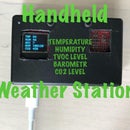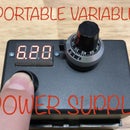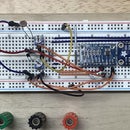Introduction: Make a Wooden Glider
Making Balsa wood gliders is fun and easy. They are very low cost and can be easily repaired if they get damaged or broken. You can use them indoors or outdoors and you can even add a rubber band launcher to achieve great distance and height. After building your glider, feel free to tweak any part of the design to improve flight time or distance. Have fun making!
Also please vote for me in the make it fly challenge!
Supplies
Materials:
1 sheet of balsa wood, 1/16 in. (1.5 mm.) thick 9 x 2 in. (228 x 50 mm.)
https://www.amazon.com/BALSA-WOOD-sheets-460mm-1-5...
1 sheet of balsa wood, 1/16 in. (1.5 mm.) thick 16 x 4 in. (406 x 101 mm.)
(buy at your local craft store)
1 balsa wood beam, 5/32 x 5/16 x 9 in. (4 x 8 x 228 mm.)
https://www.ebay.com/p/Midwest-Balsa-Basswood-Econ...
Modeling clay, about 1/2 oz.
https://www.amazon.com/Sargent-Art-22-4084-1-Pound...
Tools:
Hobby knife
Pencil
Ruler
Super glue
Sanding sponge or sandpaper
Step 1: Make Front Wings
For this part, you are going to use your 16x4 in. piece of balsa wood. If your piece is bigger, use a ruler and mark 16x4 in., then cut out the marked rectangle with your hobby knife.
- Using your ruler and starting at 4 in. long side, measure 8 in. to the center of the piece and mark two points: one towards the bottom and another near the top. Connect the lines. You should now have a line running through the middle from top to bottom (see pictures for clarification).
- Measure one inch up from the bottom left corner. Mark the wood at one inch. Repeat on opposite side.
- On the right side, place a straight edge (or ruler) so it starts on the 1 inch mark at the bottom and goes to the top middle(the top of the line running from top to bottom). Using the straight edge, make a straight line along the ruler, making a diagonal line (see pictures for clarification). Repeat on opposite side.
- Using your hobby knife, cut along the lines you just drew creating a wing shape.
- Using your hobby knife, carefully score along the line running from top to bottom. This will allow us to slightly angle the wings.
- With the scored part on top, slightly bend/fold along the scored line angling the wings downward(see pictures for clarification). Then put a long thin line of super glue down the center of the crack that opened in the wood. Then set to dry for about 5 minutes.
- We now have to sand the wood to create an airfoil kind of shape, creating lift and allowing air to flow more easily over the wing. This step is optional. You can do this step if you want your plane to glide better. Using the sanding sponge or sandpaper, sand the front of the wing down, to a blunt tip (see picture"front of wing" for clarification). Sand the back of the wing to a tapered point. Tip: be careful when sanding the wing as balsa wood breaks easily.
- You are now done with the front wings! Part 2 will show you how to make the back wings.
Step 2: Make Back Wings and Tail
- For this part, we are going to use the 9x2 in. piece of balsa wood. Using your ruler and starting at 2 in. long side, measure 6 in. of the piece and mark two points: one towards the bottom and another near the top. Connect the lines. You should now have a line running from top to bottom (see pictures for clarification).
- Now, using your hobby knife, cut along the line you just marked. We will be using the larger piece, the 6x2in.
- Using your ruler and starting at 2 in. long side, measure 3 in. to the center of the piece and mark two points: one towards the bottom and another near the top. Connect the lines.
- Measure 1/4 in. up from the bottom left corner and mark. Repeat on opposite side.
- On the left side, place a straight edge (or ruler) so it starts on the 1 inch mark at the bottom and goes to the top middle (the top of the line running from top to bottom). Using the straight edge, make a straight line along the edge, marking a diagonal line (see pictures for clarification). Repeat on opposite side.
- Using your hobby knife, cut along the diagonal lines you just marked. Save one of the leftover triangles that get cut off. It will be used for the tail wing. I will refer to it as triangle B. I will refer to the larger triangle as triangle A
- Using the sanding sponge or sandpaper, sand the front edge of Triangle A to a tapered edge. Also sand the front edge of triangle B to a tapered edge.
- Using your super glue, glue the bottom of triangle B on top of triangle A along the line marked in step 3. Face the tapered point of triangle B towards the tip of Triangle A (see pictures for clarification).
- The tail wing is now complete. Part 3 will show you how to assemble your glider.
Step 3: Assemble Glider
- Take the beam and using the ruler, measure 1in. from one end of the the beam. Mark with your pencil at 1in. from the end.
- Place the front wing assembly on the beam, with the front tip of the triangle touching the mark. Make sure the wings are angled up when they are sitting on the beam.
- Using the super glue, glue the front wings in place on the beam. Make sure the wings center is flat on the beam and is aligned.
- Using the ruler, measure 2 in. from the back of the front wings on the beam. Mark at 2 in. from the back of the beam.
- Take the back wing assembly (triangle A glued to triangle B) and place triangle A on the beam with the tip of the front touching the mark. Make sure that triangle A's tip is touching the mark and is flat and aligned with the beam. Glue in place on beam. leave about 5 minutes to dry. Tip: don't try flying the glider yet; although it looks complete, it does not have the proper weight in the front, and therefore will not fly.
- The glider is nearly complete. Part 4 will show you how to put weight in front to allow your glider to fly.
Step 4: Add Front Weight
In order to get your glider to fly, you need to add weight to the front. to do this we will use the modeling clay.
- Pull off a small piece of modeling clay. Roll it into a cylinder about 1 in. long and 1/2 in. across (see pictures for clarification).
- Poke the front of the plane into the circular side of the cylinder. Don't push the nose all the way through the clay. Leave about 1/8 in. in front of the nose of the plane.
Step 5: Flying Your Glider
To fly, pinch the beam under the center of the front wings with your thumb and forefinger. bright your arm back so the plane is level with your shoulder. Keeping the plane level, bring your arm forward at a medium speed, the plane slightly angled up. Release when the plane is about 1 foot from your shoulder. See the video of the glider in flight below.
Attachments
Step 6: Optional- Rubber Band Launcher
Additional Materials:
1 wood dowel, 0.4 in. (11 mm.) x 12 in. (305 mm.)
1 eyelet
1 medium sized rubber band
1 balsa wood beam, 0.2 in. (6 mm.) x 0.2 in. (6 mm.) x 5 in. (127 mm.)
Steps:
- Start with the eyelet and the wooden skewer. Screw the eyelet partway into one end of the skewer.
- Slip the rubber band through the small opening on the eyelet. You may have to bend the eyelet with pliers a little to get the rubber band to slip in,
- Tighten the eyelet the rest of the way down. This is your launcher.
- Using your hobby knife, cut a diagonal cut at around 35º about 1/4 in. from the edge. Keep the smaller piece.
- Using your super glue, glue the piece from step 4 to the underside of the beam on the plane about 2 in. from the front tip of the plane. Let it dry for about 5 minutes.
- Your rubber band launcher is now complete. to launch, hook the rubber band in the little piece of wood angled out. Pull the plane back, aim up and release. the plane should fly up high, then glide back down. See troubleshooting tips in the troubleshooting section.
Step 7: Troubleshooting
Hand throw
If your glider nosedives:
- If your glider falls forward sharply, remove some weight from the front, then try flying again. Repeat this until your glider flies straight.
If your glider flies forward, then falls backward:
- If your glider flies forward, then falls down or falls backward, add some weight to the front, then try again. repeat this until your glider flies straight.
Rubber Band:
If your glider doesn't fly up, just goes down:
- If the glider does not fly up but only crashes back down, add more weight to the front. you may also be pulling the rubber band back too hard
If your glider flies up high, but then nosedives:
- If the glider flies up high in the air, but then nosedives, you may need to take some clay off the front. You may also try adding a very small amount of clay to the back end of the beam.





